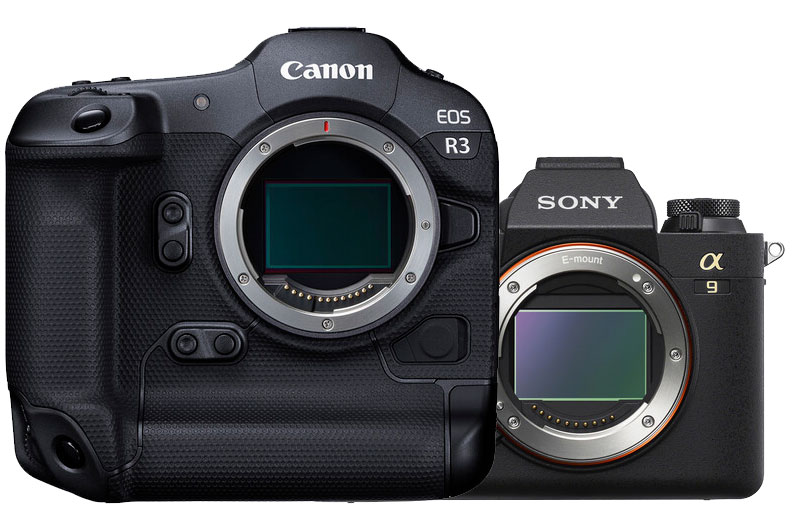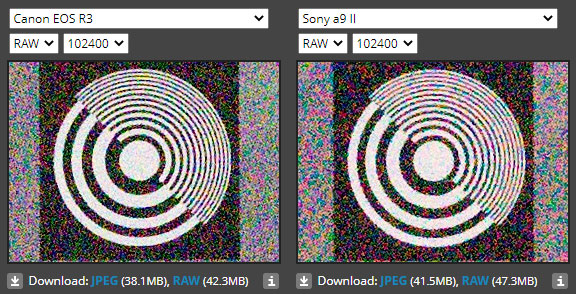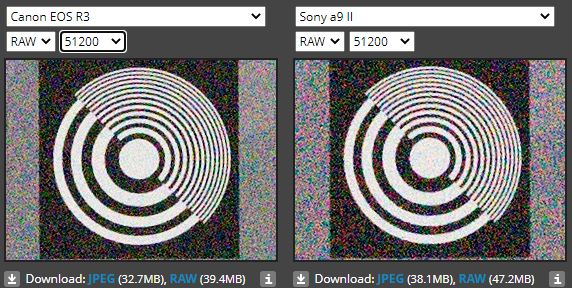
The price of the Canon EOS R3 is between the Sony Alpha A 1 as well as the A9 II camera.
And before begin to compare the specification of both cameras, Since the price range of the Canon EOS R 3 camera is slightly high, The R3 is $6K, the A1 is $6.5K, and the A9II is $4,500. So we have to consider the price factor also while comparing the specification with a 9 II.
Later on, in the next few days, we will also compare the Canon EOS R 3 camera with Sony Alpha A1.
Basic Design Difference
If you talk about body design then, of course, Canon EOS R 3 camera is slightly larger due to the attached or inbuilt battery grip with it. The Biggest advantage of the inbuilt battery grip, the overall design of the camera becomes too professional and heat also helps professional photographers to operate the camera perfectly with more controls and additional battery backup.
Sony Alpha A9 II the camera doesn’t have that if you want to attach a battery grip you have to buy a whistle battery wave which is available somewhere around $300.
| Lens Mount | Canon EOS R3 | Sony A9 II |
| Sensor Type | 36 x 24 mm (Full-Frame) CMOS | 35.6 x 23.8 mm (Full-Frame) CMOS |
| Sensor Resolution | Actual: 26.7 Megapixel Effective: 24.1 Megapixel |
Actual: 28.3 Megapixel Effective: 24.2 Megapixel (6000 x 4000) |
| Crop Factor | None | None |
| Aspect Ratio | 1:1, 3:2, 4:3, 16:9 | 1:1, 3:2, 4:3, 16:9 |
| Image File Format | JPEG, Raw, HEIF | JPEG, Raw |
| Bit Depth | 14-Bit | 14-Bit |
| Image Stabilization | Sensor-Shift 8 Stops, 5-Axis | Sensor-Shift 5.5 Stops, 5-Axis |
Let’s compare the image quality of the recently announced Canon EOS R3 camera with the ultra-popular Sony A9 II camera. We are comparing the highest test images of the camera in the comparison below.
Sensor image quality

As you can see in the images above, it’s great to see that Canon’s latest 24 MP BSI CMOS Stacked sensor of Canon R3 is at least producing the same level of noise as we have in the Sony A9 II Camera.

Now at the 51200 ISO range, you can see that the Color noise of the Canon EOS R3 camera sensor is very well controlled compared to the color noise we have in the A9 Mark II camera.
So, from the Basic test, it’s visible that the Canon EOS R3 Camera sensor can control the color noise in a better way compared to the Sony flagship camera sensor.
Exposure Control
| Canon EOS R3 | Sony A9 II | |
| ISO Sensitivity | Auto, 100 to 102400 (Extended: 50 to 204800) | Auto, 100 to 51200 (Extended: 50 to 204800) |
| Shutter Speed | Mechanical Shutter 1/8000 to 30 Second Bulb Mode Electronic Shutter 1/64000 to 30 Second in Manual Mode 1/64000 to 30 Second in Shutter Priority Mode 1/8000 to 30 Second in Aperture Priority Mode 1/8000 to 30 Second in Program Mode Bulb Mode |
Mechanical Shutter 1/8000 to 30 Seconds Bulb Mode Electronic Shutter 1/32000 to 30 Seconds Bulb Mode |
| Metering Method | Center-Weighted Average, Evaluative, Partial, Spot | Center-Weighted Average, Highlight Weighted, Multi-Zone, Spot |
| Exposure Modes | Aperture Priority, Manual, Program, Shutter Priority | Aperture Priority, Manual, Program, Shutter Priority |
| Exposure Compensation | -3 to +3 EV (1/3, 1/2 EV Steps) | -5 to +5 EV (1/3, 1/2 EV Steps) |
| Metering Range | -3 to 20 EV | -3 to 20 EV |
| White Balance | Auto, Cloudy, Color Temperature, Custom, Daylight, Flash, Fluorescent (White), Shade, Tungsten | Auto, Cloudy, Color Temperature, Custom, Daylight, Flash, Fluorescent (Cool White), Fluorescent (Day White), Fluorescent (Daylight), Fluorescent (Warm White), Incandescent, Shade, Underwater |
| Continuous Shooting | Electronic Shutter Up to 30 fps at 24.1 MP for up to 150 Frames (Raw) / 540 Frames (JPEG) Mechanical Shutter Up to 12 fps at 24.1 MP for up to 1000 Frames (Raw) / 1000 Frames (JPEG) |
Up to 20 fps at 24.2 MP for up to 239 Frames (Raw) / 361 Frames (JPEG) Up to 10 fps at 24.2 MP for up to 239 Frames (Raw) / 361 Frames (JPEG) |
| Interval Recording | Yes | Yes |
| Self-Timer | 2/10-Second Delay | 2/5/10-Second Delay |
Video Comparison
| Canon EOS R3 | Sony A9 II | |
| Recording Modes | Raw 12-Bit 6K (6000 x 3164) at 23.976p/24.00p/25p/29.97p/50p/59.94p [720 to 2600 Mb/s] H.265/MP4 4:2:2 10-Bit DCI 4K (4096 x 2160) at 23.976p/24.00p/25p/29.97p/50p/59.94p/100p/119.88p [85 to 1880 Mb/s] UHD 4K (3840 x 2160) at 23.976p/25p/29.97p/50p/59.94p/100p/119.88p [85 to 1880 Mb/s] Full HD (1920 x 1080) at 23.976p/25p/29.97p/50p/59.94p/100p/119.88p [28 to 470 Mb/s] H.264/MP4 4:2:0 8-Bit DCI 4K (4096 x 2160) at 23.976p/24.00p/25p/29.97p/50p/59.94p/100p/119.88p UHD 4K (3840 x 2160) at 23.976p/25p/29.97p/50p/59.94p/100p/119.88p Full HD (1920 x 1080) at 23.976p/25p/29.97p/50p/59.94p/100p/119.88p |
XAVC S UHD 4K (3840 x 2160) at 24.00p/25p/29.97p [60 to 100 Mb/s] Full HD (1920 x 1080) at 24.00p/25p/29.97p/50p/59.94p/100p/119.88p [50 to 100 Mb/s] AVCHD Full HD (1920 x 1080) at 50i/59.94i [17 to 24 Mb/s] |
| External Recording Modes | 4:2:2 10-Bit DCI 4K (4096 x 2160) at 23.976p/24.00p/25p/29.97p/50p/59.94p UHD 4K (3840 x 2160) at 23.976p/25p/29.97p/50p/59.94p |
4:2:2 8-Bit UHD 4K (3840 x 2160) at 24.00p/25p/29.97p Full HD (1920 x 1080) at 24.00p/50i/50p/59.94i/59.94p |
| Recording Limit | Unlimited | NTSC/PAL |
| Video Encoding | NTSC/PAL | Built-In Microphone (Stereo) External Microphone Input (Stereo) |
| Audio Recording | Built-In Microphone External Microphone Input |
AC3, Dolby Digital 2ch, Linear PCM |
| Audio File Format | AAC, Linear PCM |
| Canon EOS R3 | Sony A9 II | |
| Focus Type | Auto and Manual Focus | Auto and Manual Focus |
| Focus Mode | Continuous-Servo AF (C), Manual Focus (M), Single-Servo AF (S) | Continuous-Servo AF (C), Direct Manual Focus (DMF), Manual Focus (M), Single-Servo AF (S) |
| Autofocus Points | Phase Detection: 1053 4779 selectable AF points | Phase Detection: 693 Contrast Detection: 425 |
| Autofocus Sensitivity | -7.5 to +20 EV | -3 to +20 EV |
Both cameras feature class-leading autofocusing mechanisms inside them. Even if you compare as you can see in the table above the R3 camera is capable of shooting up to 30 frames per second whereas Sony Alpha A9 II can shoot up to 20 frames per second. So, if we compare the buffer then the Canon A3 camera does have a bigger buffer to capture or grab more frames compared to the A92.
And the next eye-catching thing is the autofocusing feature of the Canon EOS r 3 camera. So that’s an added advantage we are getting with Canon which is of course not present in Sony.
Viewfinder
| Viewfinder Type | Electronic (OLED) | Electronic (OLED) |
| Viewfinder Resolution | 5,760,000 Dot | 0.5″ |
| Viewfinder Eye Point | 23 mm | 3,686,400 Dot |
| Viewfinder Coverage | 100% | 23 mm |
| Viewfinder Magnification | Approx. 0.76x | 100% |
| Diopter Adjustment | -4 to +2 | Approx. 0.78x |
| -4 to +3 |
Conclusion
The overall specification of the Canon R3 looks very impressive, but we have to remember that both have a good price difference between them. So, if you are able to spend more you can also buy the flagship Alpha A camera. Or if you want to save a few bucks then A9 II is slightly better. But, in the end, if you are a Canon sensor color tone lover as I am then you have no option other than to move on to Canon EOS R3.






